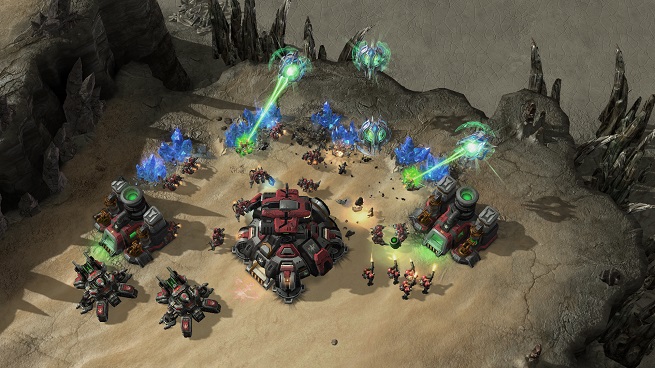
What You Won’t Like
StarCraft II probably didn’t need the new units
While the new multiplayer troops offer additional flexibility — and I look forward to seeing what pro players are able to do with them — they also feel somewhat uninspired and provide overlapping roles to existing soldiers from Wings of Liberty.
The Hellbat, for instance, is clearly channeling the fan-favorite Firebat from the original 1998 game. But its other half, the Hellion buggy that it can transform into, has been a part of StarCraft II from release. The cone of the flame attack is wide instead of long, and it’s armored instead of fast, but you’re going to use them mostly against weak swarming enemies, and the Hellion is already suited to that. The Widow Mine, again clearly designed after the original game’s Spider Mine ability on the Vulture hover-cycle, has a short range — any advancing enemy with a detector will make short work of them — but it shines against mass ground-based melee units with its explosive payload … one that’s very similar to the Raven’s Seeker Missile.
The Viper’s cloud ability comes from the original’s Defiler support unit, but unlike before — as StarCraft purists will notice — it’ll also affect your own units’ ranged fire, limiting its effectiveness. Swarm Hosts are slow moving and have a lengthy setup time of burrowing, releasing Locust egg sacks, and then waiting for the critters to hatch and move toward the enemy. They feel like an attempt to give Zerg a Terran Siege Tank, but the long preparations required means that they won’t be the key unit turning the tides of battle, and Brood Lords already fill this role from the skies.
The Protoss have the best-thought-out of the bunch even with the Mothership Core just being a weaker version of the existing Mothership. Blizzard has positioned the Oracle as a gatherer harassment unit designed to pick off hapless drones, SCVs, and probes and mess with the opponent’s economy. The Phoenix, though, already fills this role well. The Tempest gives Protoss a long-range flying heavy-hitter despite the Colossus being an excellent siege unit. The method is a little different but the roles are very similar.
The campaign is a little bit ‘Days of our StarCraft Lives’
Heart of the Swarm has nothing to say, and it is never more apparent than when Kerrigan needs to rescue Jim Raynor from the clutches of Emperor Mengsk. A dashing young prince sporting impressively large pauldrons says that the Battlecruiser holding our favorite rugged space marine is set to jump periodically to randomly selected coordinates in space. It’s impossible to get Raynor, he says. Kerrigan replies that the ship would need to resupply, and our royal friend with the massive shoulder pads says “exactly” with completely unearned confidence. Wasn’t he just lamenting that tracking this ship is hopeless?

Characters in Heart of the Swarm utter lines — dialogue consisting of “wisecracks” so cheesy that even Arnold Schwarzenegger would decline the script — to merely move along the plot. At times, they may come maddeningly close to making a point, but they quickly abandon larger concepts to advance the story to the next big action set piece. And even then, Heart of the Swarm never presents or organizes these ideas into a cohesive theme. All you’re left with is empty musings on “power” and the “final war.”
Blizzard presents the campaign with the same enthusiasm for a well-crafted narrative as a certain sci-fi director of a certain prequel trilogy that we all love to hate. That is to say, prepare yourself for a lot of boring conversation with over-the-shoulder camera shots sandwiched in between spectacular prerendered battles. Repeat ad nauseam. Roll credits.
The story hits you with a whimper, builds up to nothing, and quickly leaves your mind as if you’d not just spent the last 27 missions guiding Kerrigan through this ultimately fruitless journey.
Conclusion
No one expected the single-player campaign to be a milestone in video game literature, so I can excuse its meandering tone and appreciate it as a window into StarCraft’s development. That development, though, began in 2003, seven years before the initial release of Wings of Liberty. That’s not uncommon for the studio, but it also means that Blizzard has had a lot of time to expertly balance its pinnacle of RTS design.
The decision to split off the campaign into three separate releases, though, creates fan expectation that Blizzard will add new units for multiplayer with each expansion. Heart of the Swarms’ additions, while adding flexibility, are ultimately uninspired, drawing too much from the past rather than bringing something new to the table. Based on this showing, I’m worried about what Blizzard can meaningfully include with the upcoming Protoss campaign, Legacy of the Void.
Score: 80/100
StarCraft II: Heart of the Swarm released for PC on March 12. Blizzard Entertainment provided GamesBeat with a download code for the purpose of this review.
VentureBeat's mission is to be a digital town square for technical decision-makers to gain knowledge about transformative enterprise technology and transact. Learn More
